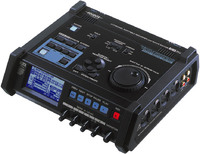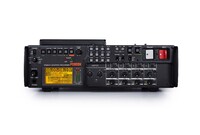Four Track Comes of Age
 Fast forward almost a decade, and various formats of digital began to replace analog two track. First there was two track digital, and except for the difference in hardware, the mixing style was the same as it was back in the day of the Nagra two track analog tape recorders.
Fast forward almost a decade, and various formats of digital began to replace analog two track. First there was two track digital, and except for the difference in hardware, the mixing style was the same as it was back in the day of the Nagra two track analog tape recorders.
Two track digital soon evolved into four track digital, and a new style of mixing began to take hold.
 The sound mixer and editors had a choice. All of the production mics could be split amongst the four available tracks, similar to the way we used to mix to the two track. Only this time, there were four places to separate booms, plants, and lavaliers.
The sound mixer and editors had a choice. All of the production mics could be split amongst the four available tracks, similar to the way we used to mix to the two track. Only this time, there were four places to separate booms, plants, and lavaliers.
Although this seemed very efficient from a sound designer’s perspective, it did cause some problems when it came to dailies and picture edits. It was not always practical to re-mix the four tracks into something that would sound decent during basic playbacks. Merely combining all four tracks simultaneously would result in phasing issues, echo & dropouts, and horrible balance.
 Instead, most soundmixers went back to the old school way of doing things. It was a return to mixing the way we did for the monaural soundtrack of the Nagra 4.2 -- a live production mix, able to stand on its own for dailies and picture edit.
Instead, most soundmixers went back to the old school way of doing things. It was a return to mixing the way we did for the monaural soundtrack of the Nagra 4.2 -- a live production mix, able to stand on its own for dailies and picture edit.
However, tracks 2 thru 4 were not wasted. Clean iso’s of key microphones, or groups of microphones, could be recorded clean for later use in post-production.
Physically, most mixing panels were easily capable of outputting four sub-mixes or direct outs from individual mics.
Today, there are two popular approaches to using a four track system. One popular techniques is to record a live mixdown onto one track, and to utilize the remaining tracks for ISO backup tracks of individual microphones, or groups of microphones (via a pre-fader Aux send).
The alternate approach is to record two monaural live mixdowns, along with only two ISO tracks. Although the content of each of the live mixdowns would be the same (aka dual mono), the second of the mono mixes would be recorded 10 to 15dB attenuated. In the event that an actor clips on the primary mixdown track, the editor would only need to bounce down to the alternate mix track in order to remedy the over modulation, and then return to the primary track for the other actors. This technique is very convenient and far less labor intensive than trying to completely reconstruct all of the audio dynamics in the scene by rebuilding a soundtrack from the ISO’s.
